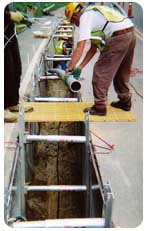Trench shoring is a process used to stabilize trench walls during the process of construction. It is mostly used during the process of excavating or maintaining pipelines or other utilities found beneath the ground. The dangers presented by trenches are well known in the world of construction. Workers must create a safe environment while working these trenches in order to leave in one piece.
Shoring is a process that occurs when a support system for the trench face is provided. The provided support system workers to prevent the foundations, soil, or underground utilities from caving in. When the depth or location of a cut that slopes back to the maximum amount is impractical, workers use a shoring process. Wales, struts, sheeting, and posts are all used together to create a shoring system. Aluminum Hydraulic shoring and Timber shoring are the two basic shoring system types.
Today, people have begun utilizing the Aluminum Hydraulic System more than the Timber Hydraulic system. The Aluminum Hydraulic System is prefabricated. It is a strut and/or wale system made almost entirely of aluminum of steel and provides a safety advantage over Timber shoring. Workers do not have to enter the trench to install or remove a Hydraulic Shoring system. Benefits associated with this type of shoring system are plenty in numbers. One benefit is that they are light enough to be installed by only one worker. They are also regulated through the use of gauges, which ensures even distribution of pressure along the trench line. The trench faces can be “preloaded” to use the natural cohesion of the soil in order to prevent movement when using this type of shoring system. Hydraulic Shoring systems can also easily adapt and work with various trench sizes (depth and width).
Shoring should always be installed from the top down. Shoring should always be removed from the bottom up. A worker should check for leaking cylinders, bent bases, leaking hoses, cracked nipples, broken connections, or any other possible defect or damage to parts that could potentially occur when using Hydraulic Shoring systems. Workers should check these systems at least once per shift.
Pneumatic Shoring is similar to Hydraulic Shoring; with the main difference being that Pneumatic Shoring uses air pressure instead of hydraulic pressure. The fact that workers have to use an air compressor on site in order for a Pneumatic system to work is seen as the biggest disadvantage. The Screw Jacks System is another type of system similar to the Pneumatic and Hydraulic systems. Screw Jacks Systems require manual adjustment which creates hazardous conditions for workers. Workers must be in the trench to adjust the strut and preloading the Screw Jacks system isn’t even an option. The Screw Jack System is also heavier in weight, making it difficult for workers to handle. Single Cylinder Hydraulic Shores are usually found in water systems and assist Timber Shoring Systems located inside shallow trenches. Single Cylinder Hydraulic Shores aide in creating face stability for areas that require face stability.
The underpinning of a shoring system involves the stabilization of any adjacent foundation, structure, or other intrusion that could potentially have a negative impact on the excavation system. It is important to consider the underpinning when discussing shoring systems. Application of the underpinning is a process that allows workers to physically reinforce the foundation itself. A registered professional engineer should always direct and approve the process of applying underpinning to a site because the process presents many hazards if not completed correctly.
Shoring and shoring boxes are two different processes. Shoring boxes do not require workers to go through and support the trench face. Shoring boxes are used with worker safety in mind and are used to protect workers from potential cave-ins or similar situations that pose a safety and/or fatal threat. OSHA standards state that any excavation area that has been excavated between the outside of the shore box and trench face should be as small as possible. This space should be backfilled so that any lateral movement that the box itself could potentially cause is prevented. Trench shields should never contain loads that exceed what the design of the system was created to handle.
Shoring boxes are normally used in opened areas, but sometimes construction sites will use the boxes in combination with sloping and benching techniques. These systems are used to protect workers from potential hazards and are both known as protective systems. Almost as important as the equipment itself, is where you get your equipment from. You want to use equipment made by individuals who care about the safety of workers as if it was them in the machinery. ICON equipment is designed with the safety of the worker in mind and is perfect to use in order to keep everyone safe. Remember, if the equipment malfunctions, the system could fail, so the right equipment is essential to creating a safe working environment.
